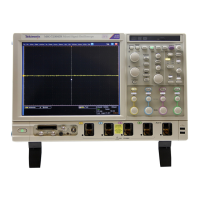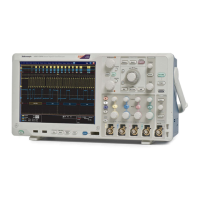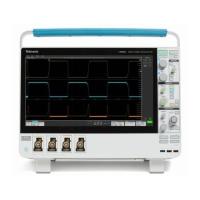Jitter 6 sigma
Jitter 6 sigma is six times the RMS value of the edge jitter in the current horizontal units.
Jitter 6 sigma = 6 × (JitterRMS)
Jitter peak-to-peak
Jitter p-p is the peak-to-peak value for the edge jitter in the current horizontal units.
Jitter PP = TCross1PP
Jitter root mean square
Jitter RMS is the RMS value of the edge jitter in the current horizontal units.
Jitter RMS = TCross 1sigma
Lock mask
Lock Mask to Waveform resizes the mask to reflect changes in the horizontal or vertical settings of the instrument.
Logic pattern
Select the Boolean logic function for the combination of the input channels. The instrument will trigger on a clock edge when the
input waveforms match the specified logic pattern.
Logic pattern inputs
The instrument input channels represent the data inputs; the channel inputs combine to form a logic pattern.
Each channel can have a value of high (H), low (L), or "don't care" (X):
■
A value is considered high if the channel input voltage is greater than the specified threshold voltage.
■
A value is considered low if the channel input voltage is less than the specified threshold voltage.
■
Use the "don't care" selection for any channels that will not be used as part of the pattern.
Logic pattern trigger criteria
Use the Pattern drop-down list to determine when the instrument should trigger.
■
Select True to trigger the instrument when the logic patterns are true.
■
Select False to trigger the instrument when the logic patterns are false.
You can also specify that the pattern is true (or false) for a specified amount of time before the instrument triggers. To specify the
time:
■
Click in the Time entry box.
■
Set the time with the multipurpose knob.
NOTE. The Time control is unavailable when you select True or False.
Oscilloscope reference
778 DPO70000SX, MSO/DPO70000DX, MSO/DPO70000C, DPO7000C, and MSO/DPO5000B Series

